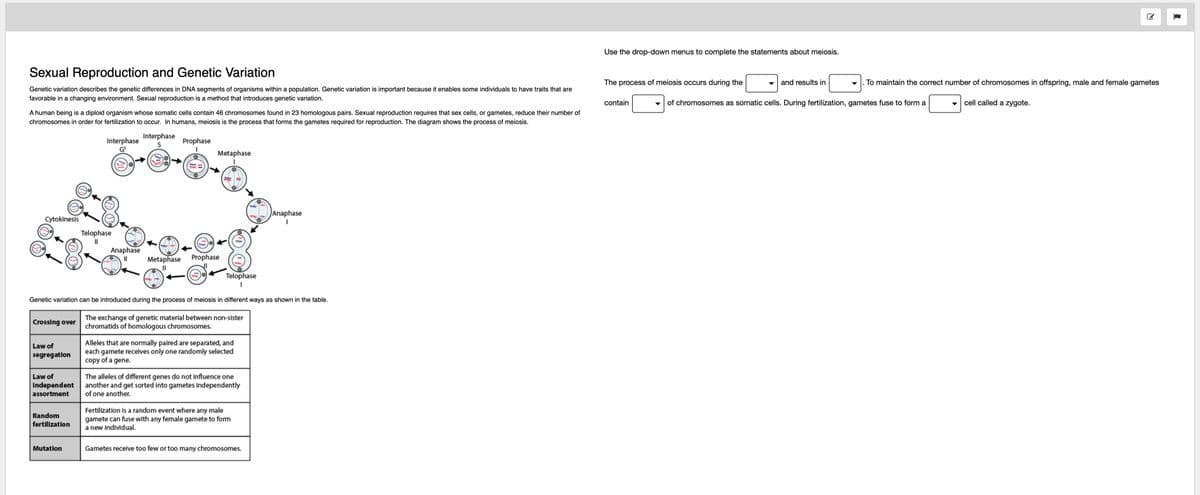The process of meiosis occurs during the cell cycle production and results in four unique diploid four identical diploid cells four unique haploid cells four identical haploid cells . To maintain the correct number of chromosomes in offspring, male and female gametes contain the same number half of the number twice the number of chromosomes as somatic cells. During fertilization, gametes fuse to form a diploid haplid cell called a zygote.
The process of meiosis occurs during the cell cycle production and results in four unique diploid four identical diploid cells four unique haploid cells four identical haploid cells . To maintain the correct number of chromosomes in offspring, male and female gametes contain the same number half of the number twice the number of chromosomes as somatic cells. During fertilization, gametes fuse to form a diploid haplid cell called a zygote.
Biology: The Dynamic Science (MindTap Course List)
4th Edition
ISBN:9781305389892
Author:Peter J. Russell, Paul E. Hertz, Beverly McMillan
Publisher:Peter J. Russell, Paul E. Hertz, Beverly McMillan
Chapter11: Meiosis: The Cellular Basis Of Sexual Reproduction
Section: Chapter Questions
Problem 1ITD
Related questions
Question
100%
The process of meiosis occurs during the
- cell cycle
- production
and results in
- four unique diploid
- four identical diploid cells
- four unique haploid cells
- four identical haploid cells
. To maintain the correct number of chromosomes in offspring, male and female gametes contain
- the same number
- half of the number
- twice the number
of chromosomes as somatic cells. During fertilization, gametes fuse to form a
- diploid
- haplid
cell called a zygote.

Transcribed Image Text:Sexual Reproduction and Genetic Variation
Genetic variation describes the genetic differences in DNA segments of organisms within a population. Genetic variation is important because it enables some individuals to have traits that are
favorable in a changing environment. Sexual reproduction is a method that introduces genetic variation.
A human being is a diploid organism whose somatic cells contain 46 chromosomes found in 23 homologous pairs. Sexual reproduction requires that sex cells, or gametes, reduce their number of
chromosomes in order for fertilization to occur. In humans, meiosis is the process that forms the gametes required for reproduction. The diagram shows the process of meiosis.
Cytokinesis
Crossing over
Law of
segregation
Law of
independent
assortment
Random
fertilization
Interphase
G¹
Mutation
Telophase
||
Anaphase
||
Interphase
S
Telophase
I
Genetic variation can be introduced during the process of meiosis in different ways as shown in the table.
The exchange of genetic material between non-sister
chromatids of homologous chromosomes.
Prophase
1
Metaphase
Metaphase Prophase
Alleles that are normally paired are separated, and
each gamete receives only one randomly selected
copy of a gene.
The alleles of different genes do not influence one
another and get sorted into gametes independently
of one another.
Fertilization is a random event where any male
gamete can fuse with any female gamete to form
a new individual.
Anaphase
Gametes receive too few or too many chromosomes.
Use the drop-down menus to complete the statements about meiosis.
The process of meiosis occurs during the
contain
and results in
. To maintain the correct number of chromosomes in offspring, male and female gametes
cell called a zygote.
of chromosomes as somatic cells. During fertilization, gametes fuse to form a
Expert Solution
This question has been solved!
Explore an expertly crafted, step-by-step solution for a thorough understanding of key concepts.
This is a popular solution!
Trending now
This is a popular solution!
Step by step
Solved in 2 steps

Knowledge Booster
Learn more about
Need a deep-dive on the concept behind this application? Look no further. Learn more about this topic, biology and related others by exploring similar questions and additional content below.Recommended textbooks for you

Biology: The Dynamic Science (MindTap Course List)
Biology
ISBN:
9781305389892
Author:
Peter J. Russell, Paul E. Hertz, Beverly McMillan
Publisher:
Cengage Learning

Biology: The Dynamic Science (MindTap Course List)
Biology
ISBN:
9781305389892
Author:
Peter J. Russell, Paul E. Hertz, Beverly McMillan
Publisher:
Cengage Learning